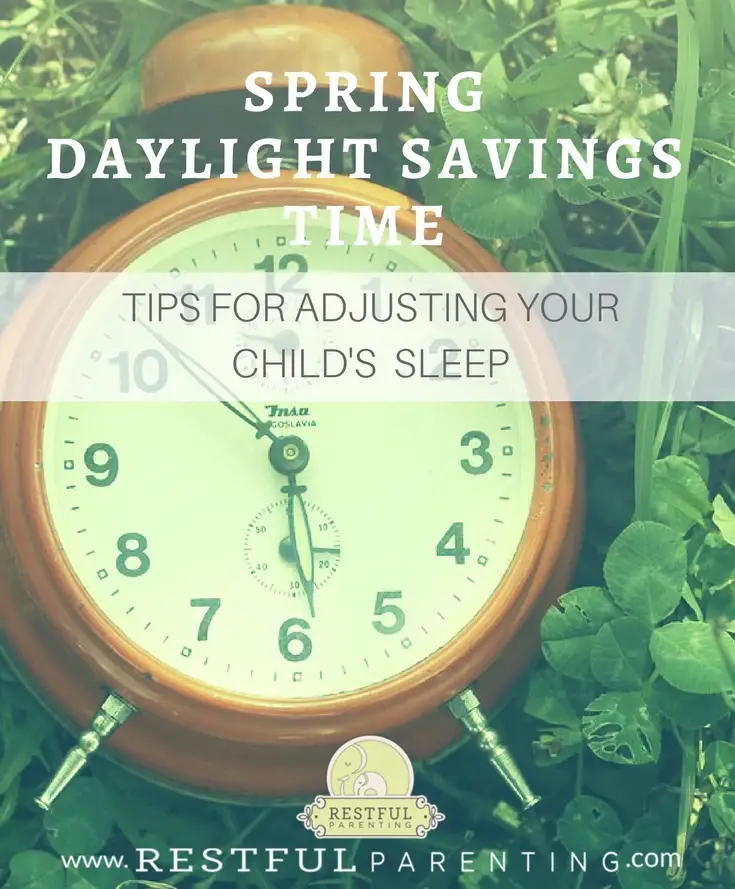Spring Daylight Savings Time Tips for Adjusting Sleep
Share this:

Daylight Savings is just around the corner!! 3am (EST) on Sunday, March 11th! (For most of us in Canada that is)
Have you thought about it? Are you worried about what may happen with your baby’s sleep? We’ve got some strategies and tips for adjusting sleep during Daylight Savings Time.
Of the two Daylight Savings Time changes we make each year, the Spring one can be the easier one for most kids to adjust to, especially those early risers! Losing an hour though during the Spring time change can be a little trickier of an adjustment for some kids. It may take their bodies a little longer to adapt while their internal clock is re-establishing.
Whoever decided that Daylight Savings was a great idea, probably didn’t have kids that napped! One thing to keep in mind about this time change is that their body clocks will be used to it being one hour earlier than their new time on Sunday. So don’t be surprised for the Sunday and few nights after that if they play around in bed for a bit before actually going to sleep. It can take their body clocks a little time to get used to the new time. If your child usually went to sleep no problem for bed at night, expect a little more rambunctiousness the days that follow the time change.
Early Risers
Daylight Savings can be great news for the families of the early risers! If your child is waking at 5:00am, they will likely start sleeping until 6:00am. If you would like to maintain the 6:00am wake up be mindful of what time your little one is going to bed at. Pushing your child’s bedtime too late will cause the early rising to begin again. Try and maintain the schedule as consistently as possible including naps and bedtime. You can read more about dealing with early rising here and here.
Babies Not on a Schedule
For young babies not on set schedules yet and working off of wake windows, you will get away with not having to do that much in terms of prepping or much afterwards. You may notice that baby is tired a little bit before his usual wake window so you can put the little one down slightly earlier and then stretch it again after a few days.
Strategies to deal with the time change:
We understand how complicated the time change can be so we’ve broken it down into three different strategies you can use to help your little one through the transition of daylight savings.
How your child copes with the time change really comes down to your child and how they handle changes in their routine. Below is a sample schedule based on a child who wakes between 6:30am and 7:00am, with a 9am and 1pm nap, and a 7:00 pm bedtime. Choose the option that you feel your child will respond to best and adjust it based on their daily schedule.
Strategy #1: Stick to your pre-daylight saving schedule.
This may be easier for parents to follow and for busier families that need to maintain the same wake up times and bedtimes. The morning after the time change, wake your child at the same time that they normally wake up at and the rest of the day will follow suit. Keep all meals, naps and bedtime the same as before the time change.
It may take up to a week for your little one’s internal clock to adjust and there could be some challenges surrounding naps and bedtime on Sunday. When you are attempting to put them to bed at 7:00 pm it still feels like 6:00 pm to them but stay consistent and they will catch on quickly!
Day
Saturday
Wake Up
6:30/7:00 am
AM Nap
9:00 am
PM Nap
1:00 pm
Bedtime
7:00pm
Time Change
Sunday
6:30/7:00 am
9:00 am
1:00 pm
7:00pm
Strategy #2: Adjust the schedule by 30 minutes.
This is the most easily adaptable option and works well with most children.
An example of this schedule would be: If their usual wake time was at 7:00 am before the time change, the day before the time change you would adjust it to 7:30 am. The morning after the time change, you would wake them up at 8:00 am making sure to adjust meals, naps and bedtime accordingly. If their usual bedtime was at 7:00 pm, you would put them to bed at 7:30 pm the night before the time change and 8:00 pm the night after. You can get them back onto their regular schedule by Tuesday following the schedule below or allow your child’s internal clock a few days to adapt.
Day
Friday
Saturday
Wake Up
7:00 am
7:30 am
AM Nap
9:00 am
9:30 am
PM Nap
1:00 pm
1:30 pm
Bedtime
7:00pm
7:30pm
Time Change
Sunday
Monday
Tuesday
8:00 am
7:30 am
7:00 am
10:00 am
9:30 am
9:00 am
2:00 pm
1:30 pm
1:00 pm
8:00pm
7:30pm
7:00pm
Strategy #3: Start the morning after the time change (Sunday)
For some families preparing for the time change beforehand just isn’t feasible. We can certainly understand that struggle so here is another option you can try. Starting the morning after the time change, begin to adjust your schedule by 30 minute increments. Some children may need an extra day or two to adjust to the new changes.
Day
Sunday
Monday
Tuesday
Wake Up
8:00 am
7:30 am
7:00 am
AM Nap
10:00 am
9:30 am
9:00 am
PM Nap
2:00 pm
1:30 pm
1:00 pm
Bedtime
8:00pm
7:30pm
7:00pm
Although the time change can cause some disruption in overall sleep, routine remains especially important during this time as the consistency of the routine will give your child the cues needed to help them settle into sleep while they are adjusting to the new schedule.
And parents, don’t forget we adults can be affected by the time change too so adjust your own bedtime for several nights if needed!
If you find your family struggling with sleep, we are happy to help! Check out our services page and contact us!


